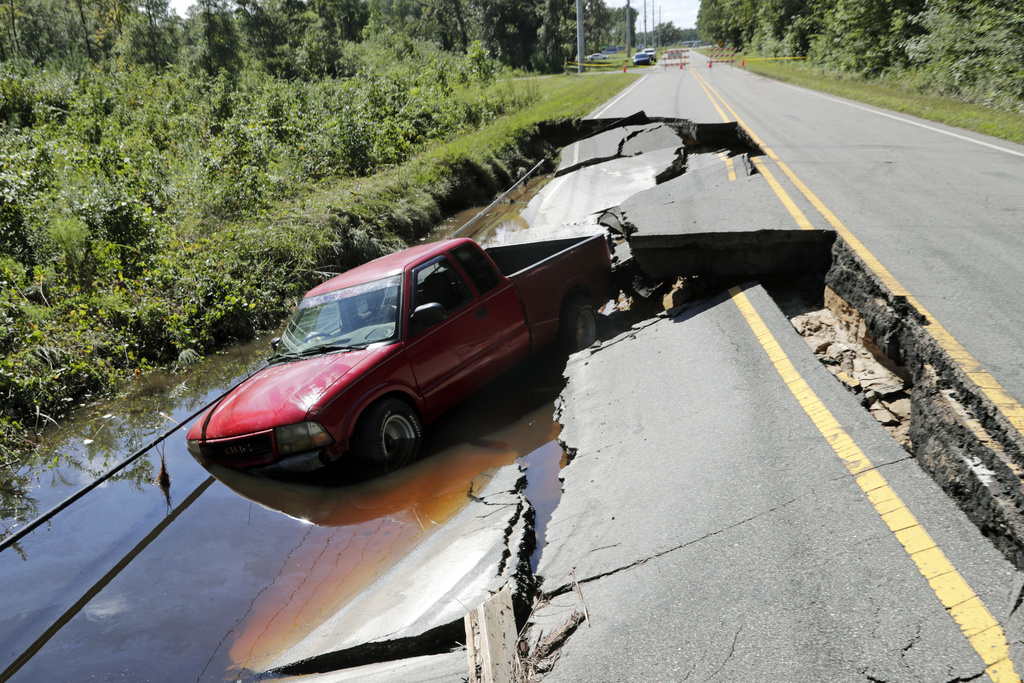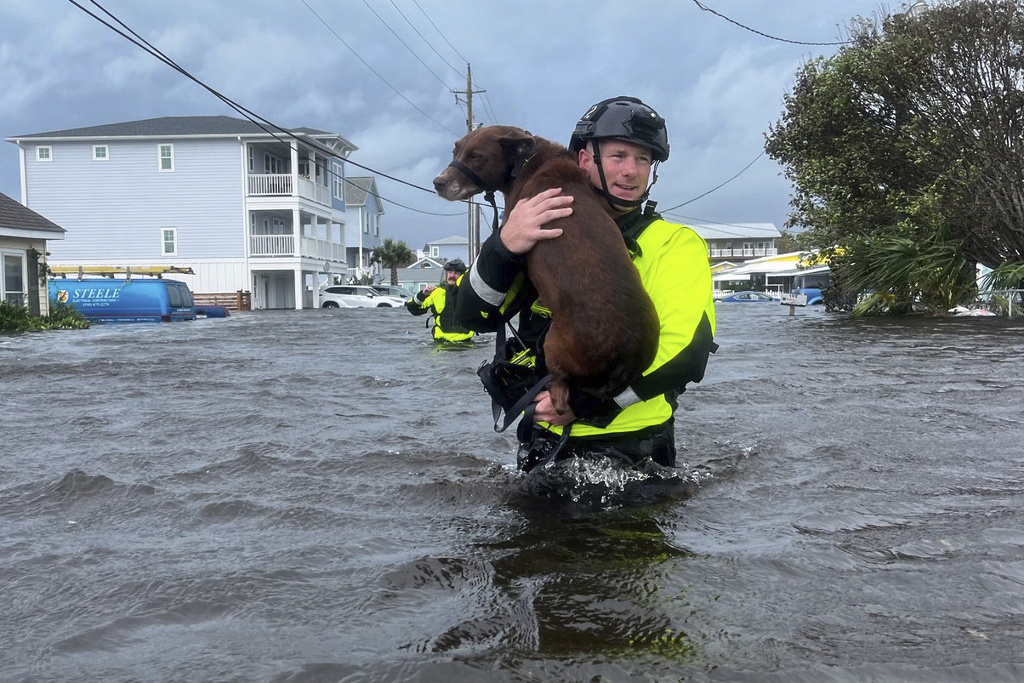Record Rainfall Causes 1,000-Year Flood in North Carolina \ Newslooks \ Washington DC \ Mary Sidiqi \ Evening Edition \ A storm in the Carolinas triggered devastating flooding, with up to 20 inches of rain in some areas, causing severe damage and road closures. Experts link this extreme rainfall to climate change, highlighting how a warming atmosphere intensifies precipitation. The storm, which wasn’t named, led to localized destruction, including flash floods that affected Carolina Beach and surrounding regions.

1,000-Year Flood Hits Carolinas: Quick Looks
- The Carolinas were hit by a storm that brought 20 inches of rain to some areas.
- A “firehose” effect caused a localized 1,000-year flood in parts of North Carolina.
- The storm left homes flooded, roads closed, and schools shut down.
- Climate experts point to climate change as a major factor in such intense rainfall.
- Carolina Beach, south of Wilmington, received 21 inches of rain in total.
- The storm was not named, leading to less public awareness and preparation.
- Tourists were still arriving in Carolina Beach as the storm hit.
- No deaths were reported, but significant damage was done to roads and homes.
- The storm system was part of a highly active hurricane season fueled by warm sea temperatures and La Niña.
Deep Look:
The Carolinas faced a catastrophic storm that led to severe flooding, with parts of North Carolina receiving an astonishing 20 inches of rain in what is being called a “1,000-year flood.” The storm, which brought flooding rains, road closures, and submerged cars, has shocked residents with its intensity, although experts in the climate community have long predicted such events as indicators of climate change.
This particular storm didn’t even earn a name, despite its devastating impact. Known as Potential Tropical Cyclone No. 8, it hovered over the southeastern part of North Carolina, with meteorologists at the National Weather Service (NWS) pointing out that one narrow band of rain acted like a “firehose,” leading to the unprecedented deluge in Carolina Beach. The rain hit with a ferocity rarely seen, dumping more than 18 inches of rain in just 12 hours and topping out at 21 inches overall by the end of the storm.
Andrew Kruczkiewicz, a senior researcher at Columbia University’s Climate School, explained that rising atmospheric temperatures are allowing the air to hold more moisture, which can then lead to more intense rainfall over shorter periods of time. He noted, “One of the clearest markers of climate change is this increase in intense precipitation, as warmer air holds more water.” These extreme events are becoming more common as the climate continues to shift, with North Carolina being particularly vulnerable to such weather events.
The staggering 21 inches of rain that fell over Carolina Beach was well beyond what forecasters had predicted, leading to flash floods that swept through neighborhoods, catching many residents by surprise. Lauren Warner, a meteorologist with the NWS in Wilmington, explained that the storm’s narrow path over the region, combined with its intensity, created what she referred to as a “firehose effect,” which focused the rain over a specific area. “If that had shifted just slightly, the totals could have been much lower, or spread across a wider area,” Warner said. Instead, parts of just two counties experienced the worst of the flooding.
In nearby Ocean Isle Beach, just 30 miles from Carolina Beach, rainfall totals were much more manageable, with less than 4 inches falling in some areas. This stark contrast over a relatively small geographic area underscores the localized nature of the event.
Carolina Beach Mayor Lynn Barbee expressed his shock at the volume and persistence of the rain, saying that even in an area accustomed to tropical downpours, nothing could have fully prepared the town for this amount of rainfall. “I’ve lived on the coast for most of my life, but I don’t think I’ve ever seen it rain so hard and for so long,” Barbee said. He highlighted the challenge of dealing with 21 inches of rain in such a short period, noting that while the town is equipped to handle typical storm surges and flooding from the ocean, they were unprepared for this kind of “falling water.”
One of the complications in preparing for the storm was the lack of a formal name, which led to less attention being paid to the system. Typically, people associate significant weather events with named storms, such as hurricanes, and may not take unnamed systems as seriously. Barbee noted that even as the rain fell in torrents, some tourists were still arriving in town for beach vacations, unaware of the danger they were facing. One family from Pennsylvania had their vacation ruined after their van was submerged in floodwaters, forcing them into a shelter rather than the rental they had planned to enjoy.
The storm’s impact extended beyond Carolina Beach, with Brunswick County at North Carolina’s southeastern tip also suffering from road closures and widespread flooding. U.S. Highway 17, a vital coastal route, was submerged in multiple places, cutting off access and stranding drivers on patches of high ground that became temporary islands. Emergency services were stretched thin, but they were able to deliver food and water to those stranded until the floodwaters receded. Brunswick County emergency officials reported that while there were no fatalities, dozens of roads were damaged or completely washed out by the flooding.
This historic flood isn’t an isolated event for the region. North Carolina has experienced several “floods of a lifetime” over the past 25 years, including major events during Hurricane Floyd in 1999, unnamed storms in 2010 and 2015, and the catastrophic 30 inches of rain dropped by Hurricane Florence in 2018. These recurring events continue to challenge local infrastructure, and experts are urging officials to rethink how they plan for these increasingly severe weather systems.
As of Tuesday, the remnants of the storm had moved into southeast Virginia, bringing additional rain but with much less intensity than what struck North Carolina. In the state’s Outer Banks, coastal highway North Carolina 12 on Ocracoke Island was closed due to the storm, and erosion around Rodanthe threatened several homes. In recent years, this area has lost more than half a dozen beachfront homes to rising sea levels and storm erosion.
With the Atlantic hurricane season continuing until the end of November, forecasters are warning that this active season is far from over. The National Oceanic and Atmospheric Administration (NOAA) updated its hurricane outlook last month, predicting a highly active season driven by near-record sea surface temperatures and the potential impact of La Niña. Residents across the Carolinas and beyond are being urged to stay prepared as the season progresses.
Elsewhere in the Atlantic, Tropical Depression Gordon swirled over open waters. Although the system is not expected to impact land in the immediate future, forecasters warned that it could either dissipate or regain strength in the coming days.
Record-Rainfall Record-Rainfall Record-Rainfall Record-Rainfall







